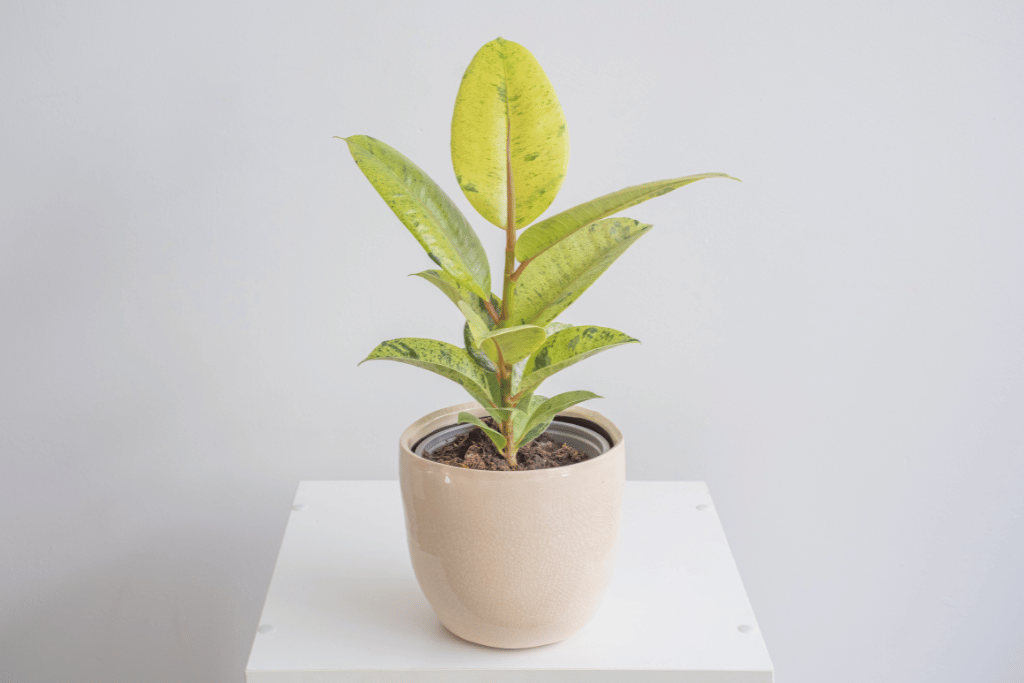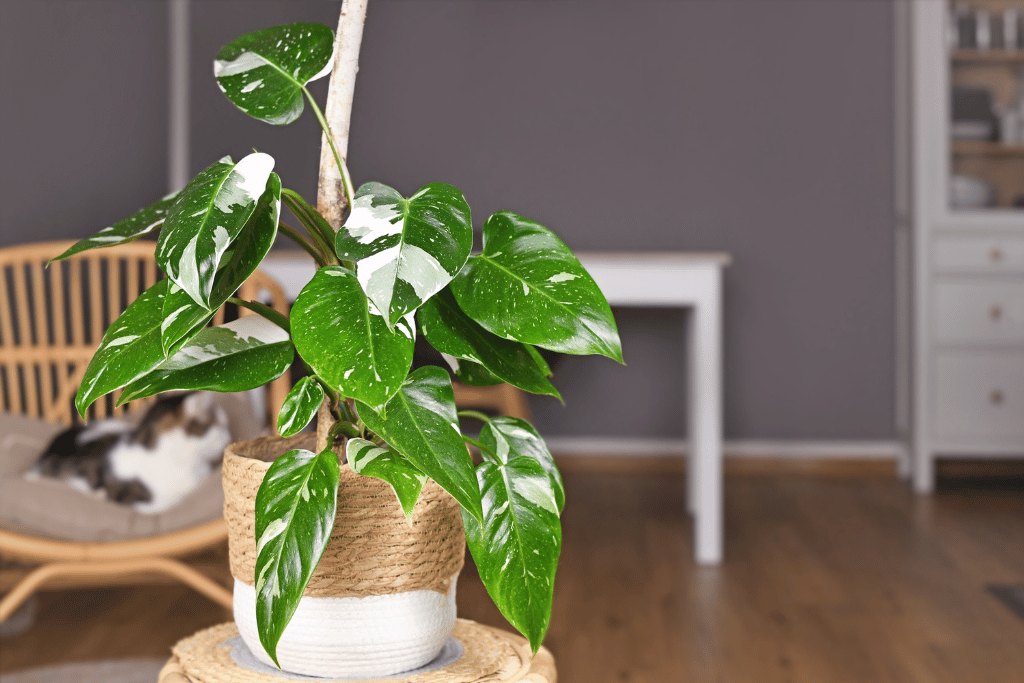
Are you in search of a houseplant that is both attention-grasping and easy to care for? Then Ficus Shivereana was designed just for your preferences! This gorgeous tropical greenery boasts thick, glossy leaves with bold patterns of creamy white and deep green, making it a stunning addition to any indoor space. Not only is it visually pleasing, but also a low-maintenance and adaptable survivor in a wide variety of growing conditions. So, whether you’re an experienced plant parent or a complete newcomer to horticulture, this lively rubber plant is the perfect choice for adding a touch of natural atmosphere to your home or office.
Ficus Shivereana Quick Facts
Ficus Shivereana is a unique rubber plant that belongs to the Moraceae family, also known as the fig family. This plant is also called Ficus Shivereana Moonshine and is a variety of Ficus lyrata, which is native to West Africa, specifically the tropical rainforests of Sierra Leone and Cameroon.
This exotic gem has large, shiny foliage that is heavily veined with white or pale green markings. It also has a unique, almost quilted texture that adds to its visual appeal. The plant grows in a bushy, compact form and can reach a height of up to six feet. It is relatively slow-growing, so you won’t have to worry about it taking over your space too quickly.
Ficus Shivereana Care Instructions
Soil
The rubber plant grows best in soil that is well-draining and nutrient-rich. A good quality potting mix containing perlite or vermiculite is recommended. These components improve the soil’s drainage and aeration, which are essential for the green’s health. Additionally, the soil should be slightly acidic, with a pH range of 5.5 to 6.5. This acidity level ensures that the plant can easily absorb the necessary nutrients.
Watering
Overwatering is one of the most common mistakes made when caring for the Ficus Shivereana. This verdant beauty prefers to be kept slightly moist but not too wet. Watering once a week and allowing the top inch of soil to dry out before sessions are one of the most essential best practices to keep. The plant’s water requirements may vary depending on the season, temperature, and humidity level. Therefore, it’s important to check the moisture level of the mix regularly to avoid overwatering or underwatering. In addition, don’t entrust self-watering containers to perform the dirty work – you may cause more harm than good.
Light

Ficus Shivereana is keen on sunbathing in bright and indirect light. Direct sunlight comes with the risk of burning its foliage, so it’s highly advised to avoid choosing an overly sunny location with direct sunlight. It’s important to know that the plant can also tolerate partial shade, but it needs at least four hours of indirect sunlight daily to maintain its best form. Of course, if you don’t have a bright spot in your home, you can always try to remedy the lack of natural light with an artificial one. Additionally, it’s crucial to rotate the pot every few months to ensure that all sides receive equal amounts of light.
Temperature
Ficus Shivereana thrives in warm temperatures between 60°F (15 C°)and 85°F (30 C°). However, it withstands temperatures as low as 50°F (10 C°) and as high as 95°F (32 C°) for short periods. Avoid placing the plant in drafty areas, as this can cause the leaves to drop. Sudden temperature changes may bring about shock, so try to sustain a consistent temperature to keep your leafy companion healthy and happy. Also, keep it away from heating and cooling vents, as these factors might negatively affect its growth.
Humidity
Since we’re talking about a tropical native, Ficus Shivereana loves having plenty of humidity in its living area. It actually enjoys it so much that its leaves are prone to drooping and dropping in arid conditions. Therefore, to increase humidity levels, you are recommended to place a humidifier near the plant, especially during the winter months when indoor air tends to be drier. Misting the foliage occasionally contributes to enhancing the water content of the air too. However, don’t flood the leaves with water, only gently spray them. Otherwise, you run the risk of your precious green developing fungal diseases. Alternatively, you can place the container on a tray filled with pebbles and water. The evaporating water will increase humidity levels around the plant.
Fertilization
This bushy attraction is a heavy feeder and requires regular fertilization to maintain its health and growth. Using a balanced product every two to three weeks during the growing season, spring to summer is recommended. During the fall and winter, you are free to reduce this practice to once a month. It’s significant to follow the manufacturer’s instructions for the appropriate dosage and frequency. Overdoing it can lead to root burn and other issues, so keep your fertilization schedule in check. Additionally, avoid providing your plant with too much extra boost during its dormant period.
Ficus Shivereana Propagation Techniques

- Select a healthy stem to work with: To start the propagation process, choose a stem from the parent plant that is at least 6 inches long and has multiple nodes, ensuring it is healthy.
- Cut it: Use a clean and sharp pair of scissors or pruning shears to cut the stem just below a node, making sure that the Ficus Shivereana cutting is clean and not jagged.
- Get rid of leaves: It’s essential to remove the leaves from the lower half of the stem, leaving only a few of them at the top to promote root growth.
- Add accelerants: To stimulate the development of the roots, dip the cut end of the stem in rooting hormone powder and ensure that any excess powder is shaken off.
- Plant in potting mix: Prepare a pot with well-draining soil and create a small hole in the center with a pencil. Insert the stem into the hole and gently firm the mix around it, making sure the bottom of the stem is properly covered with soil.
- Water the cutting: Thorough watering until the liquid drains out of the bottom of the container is essential for appropriate growth. Don’t rewater until the soil has dried out from the previous session.
- Provide proper conditions: Keep the cutting in a warm, humid location with enough indirect light. Cover the container with a plastic bag or similar item to create a greenhouse effect and retain moisture. Check the cutting regularly and mist it if the soil seems dry.
- Wait for roots to develop: After a few weeks, gently tug on the cutting to see if it has developed roots. If you feel that it holds on, roots have likely formed. If not, wait a bit longer and continue to provide proper care.
- Transplant: After the root formation, transplant the cutting into a slightly larger pot with fresh soil. Continue to give it adequate attention, including regular watering and fertilizing.
How To Properly Prune Ficus Shivereana

- First, identify the branches that need pruning. Look for branches that are diseased, dead, or crossing over other branches. You should also remove any new shoots that emerge from the base of the plant to keep it looking tidy.
- Use clean, sharp pruning shears to make your cuts. Dull blades can damage the Ficus Shivereana and leave it vulnerable to diseases.
- Make your cuts at a 45-degree angle, about a quarter-inch above a leaf node or bud. This will encourage new growth and prevent damage to the rest of the greenery.
- When removing larger branches, use a saw to make a clean cut. Avoid tearing or ripping the bark, as this increases the risk of diseases too.
- Finally, take care to dispose of any sick or dead branches properly. You don’t want to leave them lying around where they could infect other plants.
Where To Buy Ficus Shivereana
Even though the Ficus Shivereana is a relatively rare treasure to come by, it’s not impossible to get your hands on a gorgeous piece. One of the most convenient options is to buy it online. There are several reputable online plant retailers that offer a wide variety of indoor greens, including this exotic gem.
When purchasing on the internet, it’s crucial to read the product description and reviews carefully to ensure that you are getting a healthy and high-quality specimen. Look for ones that are well-established and receive positive feedback from other customers.
If you prefer to buy your rubber plant in person, you can visit your local plant nursery or garden center. These stores typically have a selection of indoor greenery, and you may well be able to find a Ficus Shivereana there.
When shopping in person, keep an eye out for any signs of pests or diseases on the plant. Your new addition should have vibrant, healthy foliage and sturdy stems.
Closing Words
So, there you have it! If you’re on the lookout for an easy-to-care-for yet stunning plant to brighten up your house, apartment, or office, the Ficus Shivereana won’t disappoint you. Its sleek, patterned leaves add a touch of a tropical vibe to any room, and it’s not too fussy about its growing conditions either. As long as you give it permeable soil, the right amount to drink, and enough sun rays to soak up, then your rubber plant is set up for a long and content life. And if you’re feeling adventurous, why not try propagating or pruning it? With a little effort, you’ll have a delightful, healthy green to enjoy for years to come!
Frequently Asked Questions (FAQ)
Is Ficus Shivereana a rare plant?
Yes, it’s considered a rare item to find both in its natural habitat and in the horticultural trade too. However, its rarity status may vary depending on the specific location, specialization of the seller, and local conservation efforts.
How tall does a Ficus Shivereana get?
Typically, the rubber fig grows to a height of 2 to 3 meters (6 to 10 feet). If this height doesn’t fit your indoor space, don’t be discouraged from getting this beautiful bush. A little pruning and maintenance of shape can work wonders in keeping the plant’s height in check. This way, it will surely make a stunning addition to your home or outdoor scenes.
Is the plant difficult to keep alive?
It is generally considered an easy-to-care-for green that adjusts to a variety of environmental factors and thrives in a range of conditions. However, like all plants, it still requires proper watering, light, and occasional fertilization to remain strong and vibrant.
What’s the average lifespan of a Ficus Shivereana?
How long a rubber plant will live depends on a number of aspects. This includes growing conditions, care, and maintenance. There’s one thing for sure though: as long as you provide your leafy friend with proper care and attention, it will live for many years, even up to 20 or longer! Regular pruning and adequate sunlight, water, and fertilization contribute to ensuring the plant’s longevity too.



